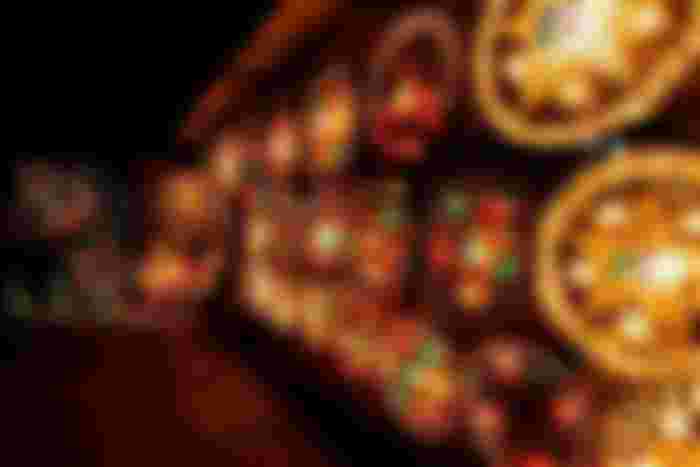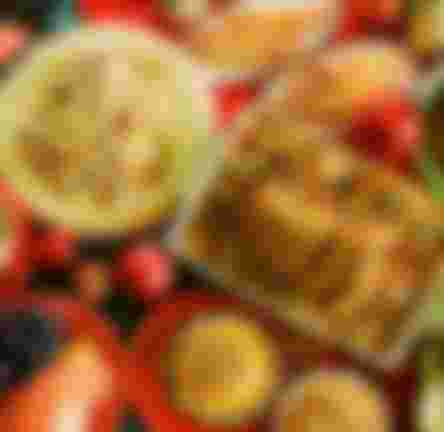December 12, 2020
The presence of Christmas is truly in the air and right around the corner. In everywhere you go - to the malls, shopping centers, department stores, supermarkets, even while riding on public vehicles - you will hear Christmas songs and see Christmas decors.

In our country, it is really normal to hear Christmas songs and see Christmas decors everywhere as early as September. The Philippines is regarded as a country that celebrates the world's longest Christmas season. Started from the first day of September until the third week of January.

As the first 'Ber month' arrived, people are already excited to decorate their houses with different parols (Christmas lanterns), belen (a creche or tableau portraying the Birth of Christ derived from the word Bethlehem), Christmas lights and trees, and other Christmas displays, and along with it is playing Christmas carols.
Filipinos around the world begin the countdown to Christmas as the first day of September mark on the calendar. For us Filipinos and to all Christians, Christmas is one of the most important traditions and season of the year.
If you will visit the Philippines during the Christmas season, there are a lot of things to do as part of Filipino culture and tradition and that made its title 'The World's Longest Christmas Season'. These are also the things I missed the most while working abroad. All countries have their way of celebrating the Christmas season but it's just so different in the Philippines.
Here are the things to do in the Philippines during the Christmas season:

Simbang Gabi or Misa de Galo in Spanish term is also called Rooster's Mass because it is held at dawn. The dawn mass services start from the 16th day of December until the 24th day and as early as 3-5 in the morning. In some parishes, masses begin at 7:30 or 8:00 in the evening.
When I was a kid, I was always excited about the Simbang Gabi because they said that God will grant your special wish if you attended and hears all nine Masses. Unfortunately, I was not allowed to attend the Simbang Gabi since it's quite dangerous to walk on a dark street for kids. There were no public vehicles yet during those hours and our village is quite far from our town proper where our church is located. The 16th day of December is not only exciting because of the first Simbang Gabi but also because it is my brother's birthday. And I also asked myself when I was young, "why is it called Simbang Gabi if it is held early in the morning?" 😅
Eat Traditional Filipino Breakfast After the Dawn Mass

After the masses, churchgoers can buy Filipino delicacies sold outside the church and can eat it either within the church precinct or take it home. Different Filipino native delicacies are offered by the vendors such as, bibingka (rice flour and egg-based cake, cooked using coal burners above and under); puto bumbong (a purple, sticky rice delicacy steamed in bamboo tubes, buttered then sprinkled with brown sugar and shredded dried coconut meat), palitaw (made from grined glutinous grains, dough is formed into thin patties, cooked in boiling water, and then coated with grated coconut, toasted sesame seeds, and sugar), and more, partnered with hot drinks such as salabat (ginger tea), tsokolate or cocoa (thick, Spanish-style hot chocolate), and coffee.
In the provinces, mass sponsors offers free breakfast to devotees after attending the mass. They distributed packed foods like champorado, sopas, pansit (vermicelli) or sandwhiches and drinks outside the church. And anyone who come out from church after the mass are free to get one.

And at home, mothers usually cooked champorado (chocolate porridge) for breakfast. Kids really like eating champorado. I suddenly craved for it since it is cold right here. My grandmother is very good at cooking champorado and she also knows how to make tablea (cacao tablets) which we usually used for making tsokolàte for breakfast.
Christmas Caroling

As the Simbang Gabi begins, the Christmas caroling also started. And the same with Simbang Gabi, it also lasted for nine nights from December 16 to 24. Filipino children even some teens and adults, visited from house to house at night and merrily sing Christmas carols along with their tambourines, guitars, drums and other intruments, or even just clapping their hands. The carols usually ends with high-pitched greeting of “Maligayang Pasko” or “Merry Christmas”.
Homeowners will then reward the carolers with small treats or coins for their effort of singing merrily. In some cases, those who perform well receives higher amount than those who didn't sing well. Then after receiving the reward, the carolers will ended it by saying "Thank you, thank you, ang babait ninyo, thank you!” (literally Thank you, thank you, you are so kind, thank you!). For naughty kids who aren't contended with their reward, they will humourously sing "Thank you, thank you, ang babarat ninyo thank you!" (Thank you, thank you, you are ungenerous thank you!" Then run away fastlt after singing the line loudly. 🤣
I personally experienced partaking the Christmas caroling and that was so fun. At the end of the caroling, the collected rewards will be divided to each member of the group. Some kids are saving money from doing Christmas caroling so they can buy gift for themselves on Christmas day.
Christmas Midnight Mass and Noche Buena

Besperas ng Pasko or Christmas Eve on the 24th day of December is celebrated with the midnight mass. For those who cannot attend the Simbang Gabi, they prefer to attend the Christmas Eve mass. And after the midnight mass, Filipino family members are gathered together to have a Noche Buena feast at home.

The traditional yuletide fare often served with foods such as queso de bola (Filipino Spanish for "ball of cheese", hamón (Christmas ham), tsokoláte (hot chocolate drink), pasta, fruit salad and fresh fruits and after the feast is the best time for exchanging and opening Christmas presents.
Kids during those hours are usually asleep but on Christmas Eve, they are fully awake and having fun while opening their Christmas presents.
Christmas Day
The Christmas Day begins with a morning mass that all family members and even the non-churchgoers are present. After the mass, Filipinos typically visit their extended family.

This custom is enacted through the "Pagmamano" a sign of giving respect to adults. It is done by taking the hand of an elder and pressing the back part of the hand against the forehead, while saying the greeting, Mano, po (literally "[Thy] hand, please"). Then the elder will respond by saying a blessing or simply acknowledging the gesture. And in return they will give "Aguinaldo" (Spanish term for bonus) or a
money in the form of crisp banknotes that is often placed in an envelope. In Chinese they called it ang pao or red pocket.

And to Godparents, they are socially obligated to give aguinaldo or presents to their godchildren. And kids are always excited for this part.
Pamamasko
Aside from receiving presents and aguinaldo from relatives and Godparents, it's been a practice in the Philippines that kids go from house to house to ask small Christmas presents from the homeowners and we call it "pamamasko".

This practice may sound demanding but homeowners really prepared gifts for kids who will knock on their door and will ask for gifts. Kids will usually say " namamasko po" a polite way of asking small gifts from the homeowners.

When I was a kid, after attending the morning mass, me and my friends and relatives will have house to house visit with our bags or any plastic bags where we can place our collected gifts from different homeowners. The gifts are either toys, school supplies, candies, chocolates, and other foods, and for some, they will give a small amount of money. At the end of the day, we are so happy as our bags are full of candies, other foods and some toys.
New Year's Eve and Media Noche

On the midnight of December 31 ( (Bisperas ng Bagong Taon), Filipino families gather together for the Media Noche, a blessful midnight feast that symbolises hopes for prosperity in the coming year.

Sometimes, Filipinos will gather on the streets where they can set up their tables for New Year's Eve parties, make noise and light firecrackers. But due to yearly ban of firecrackers, people use the safer way of merrymaking by banging on pots and pans, blowing horns or 'torotot' and even blowing car horns. Making noise is their way to greet the New Year and folks belief that it exorcises their surroundings of bad spirits and shoo away the bad lucks of the past year.

Many Filipinos also spend their New Year's Eve at the parks or places with New Year countdown parties organized by big TV Networks. They can watch and listen to different Filipino singers and celebrities while enjoying their own packed foods and waiting for the countdown with fireworks displays.
Other traditions and beliefs on Christmas Eve includes:
Wearing clothes with polka dots or other circular designs and preparing 12 circular fruits on the table like oranges, apples, grapes, and more. This symbolises coins and money and this practice believed to bring them more luck, money, and good fortune.
Children are also encouraged to jump at exactly 12 midnight to increase their height but this never happened to me as my height never increased after jumping. 🤣
All windows and doors are also open to let the blessings come in on the first day of the new year.
Food and water storage are full to prevent from hunger and scarcity and Filipino families believed that it will make them properous in the coming year.
Eating sticky foods like biko (glutinous rice cooked with coconut milk and sugar). They said that eating sticky foods will strengthen the family bond. The other belief says that stickiness is like a magnet that attracts good fortune.
Eating pansit or noodles during the New Year's Eve symbolises for longevity. This is essentially a Chinese belief that has been adopted by the Filipinos on their regional cuisines together with the belief surrounding them.
Abstaining from eating chicken and fish on New Year's Eve. These foods symbolises or are associated with food scarcity. Filipinos also have this idiom "Isang kahig, isang tuka," which literally means "one scratch, one peck." It is the chicken's way of eating that is attributed with hardship and poverty. Belief says that those who will eat chicken on New Year's Eve will become like the bird that has to scratch and peck all year around.
The last but not the least, do not spend money on the first day of the year. This belief will lead to better financial management and those who will spend money on January 1 will immediately loss their money. So some Filipinos would rather just stay at home to avoid spending money.
These are just beliefs and nowadays including our family, we even like eating 'inihaw na bangus' (grilled milky fish) and chicken adobo or fried chicken on New Year's Eve. Positive mindset, hardwork, and perseverance, those are the qualities that will help you prosper in life.
Three Kings' Day

The Three King's Day or Araw ng Tatlong Hari falls on the first Sunday of January. It is also called The Epiphany and is the official end of Christmas season in the Philippines.
It is a dying tradition of Hispanic custom where children leave their shoes out by the door, so that the Three Kings can leave gifts like small amount of money or candies inside.
In Manila, there is usually a parade on the streets organized by the prestigious club Casino Español, where the Three Kings dressed in royal robes and end at the clubhouse where children of the Spanish community are waiting and excited to receive some Christmas gifts. Some gifts are also prepared for the poor children and orphans.
Three King's day is not yet the end of the celebration, Filipinos still have festivals to celebrate on the first month of the new year.
Feast of the Black Nazarene

The miraculous Black Nazarene is borne in procession on January 9 after a novena in its honor. The procession starts from its original location in what is now Rizal Park to its present shrine in the Quiapo District of the city.
The Black Nazarene is a black statue of Jesus Christ brought to the Philippines in 1606. During the procession, the devotees will jostle one another trying to touch the Black Nazarene.

People believed that it has miraculous powers and anyone who touches the statue or even just grab on to the rope that pulls the carriage carrying the Black Nazaren will receive a miracle and will heal their illnesses.
Feast of the Santo Niño

The current date for the end of Christmas celebrations in the Philippines is the Feast of the Santo Niño (Christ Child) on the third Sunday of January.

Sinulog Festival is held in honor of the Christ Child and the celebrations are mostly focused in Cebu City. It is a festival where people danced for joy upon receiving the Santo Niño.

Some places around the country also have a water procesion for the Sto Niño. Our family as well as other Filipinos usually go the near beaches on the third Sunday of January to witness the said procession.
Christmas in the Philippines is a spirited combination of customs and traditions from American, Spanish and Chinese cultures. The preparation and celebration for this year may change
due to this pandemic crisis. I am not sure if there will be a Simbang Gabi, however, I am certain that there will still be carolings and Christmas day masses especially in the provinces. And this pandemic won't stop the Filipinos to celebrate Christmas day and New Year's Eve. Whatever happens, it is a celebration that brings Filipino families together!
Advance Merry Christmas everyone and a Happy New Year!
Thanks for reading @Jane





















When i don't think we can do our yearly traditions this year because there's still gcq but i want na mamaskooo!